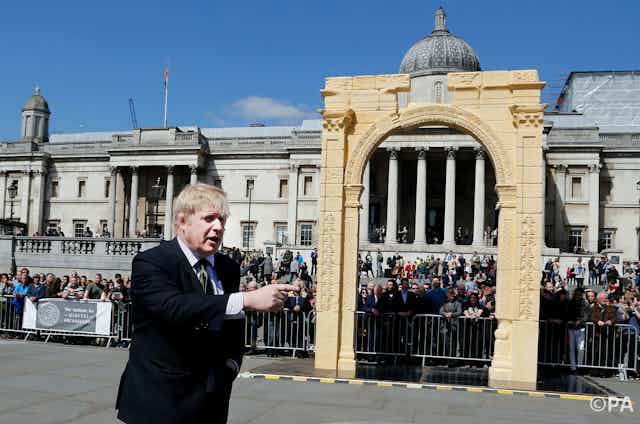A six-metre (20ft) model of Palmyra’s Triumphal Arch, made in Italy from Egyptian marble, was last week installed in London’s Trafalgar Square. Some have interpreted this “as an act of defiance” to show that restoration of the heritage site can be made possible “if only the will is there”.
“When history is erased in this fashion, it must be promptly and, of course, thoughtfully restored,” said Roger Michel, the director of Oxford’s Institute for Digital Archaeology, which is behind the project. Public opinion seems to echo this view. Local and foreign specialists have united to plan the resurrection of the ancient ruins in Syria with the help of photography and 3D printing.
If this goes ahead, it will not be the first time Palmyra has been rebuilt. Historians have shown that in the early 20th century, inhabitants were relocated from the ancient ruins to a new site outside of the town under the French Mandate.

This became Tadmur, now infamous for being home to a notorious prison and political torture. Once they were out, the village inside the ruins was destroyed to make way for the archaeological excavations and the reconstruction of the ruins of the ancient site. What became the famous tourist attraction and world heritage site known as Palmyra started with destruction.
This is an example of an overlooked feature of archaeology: the fact that excavation often demands that buildings and archaeological histories of the strata above them must often be destroyed. This sometimes included sites, such as urban settlements or, as it was the case with Palmyra’s previous use of the Temple of Bel, churches and mosques, which are meaningful heritage to some. Regard for the past is intimately tied to ideologies and politics of the present, including nation-building, identity formation and regime validation. In Israel, for example, archaeology and heritage have become powerful tools to legitimise the reclamation of the land of biblical ancestors.
Contrary to what the current debate implies, there not a “Middle East” or “heritage” deemed valuable by everyone and thus in need of saving. The past is not a finite resource: the very definition of “the past” is contestable. But the recent discussion on heritage has become increasingly monolithic, often equating “The Orient” with destruction and “the West” with salvage. Such tropes are troubling because they replicate 19th and 20th-century stances of imperialism, a context in which both archaeology as well as heritage concepts have their origins.
Whose heritage?
Of course, there is no such clear-cut difference between Western and Eastern approaches to “heritage”. Forms of iconoclasm in both the East’s and the West’s long history of visual and material demolition bear striking similarities. In most recent histories, the toppling of statues of Lenin or Saddam Hussein, for example, were clear signs of political dissent. This makes it seem unjustified to equate iconoclasm with barbarism and the appreciation of artefacts with civilisation.
Equally underrepresented are views, which show that preservation can have different guises, beyond the official forms of excavating and the subsequent safeguarding of objects and sites. “Heritage” does not necessarily entail that objects become (Western) museological trophies without a function.
This was the case, for example, when “destruction” of what is now considered heritage was required to reuse (and thus preserve) objects in new urban structures. For centuries, unearthing ancient objects was a widely accepted activity in Europe. In early Christian times and long after, artefacts, such as those from Roman temples, were removed from buildings or the soil to be recycled in churches, mosques, or other buildings. Rome’s Pantheon, for example, is a Christian conversion of a Roman building. Reworking past material is also preservation.
Successful community projects, such as that at Umm el-Jimal in Jordan, show how communities can be part of ancient heritage, informing analysis of its past and helping improve present conditions. Residents have made valuable contributions to the preservation and study of this site. Preservation, for example, came with the restoration of an ancient water system, which provides a sustainable, secure, and local source of water for the modern Umm el-Jimal’s community.
Such holistic approaches are on the rise in some areas (and they might be in the case of Palmyra). But the idea that material forms of heritage in – and from – the Middle East might embrace alternative preservation practices remains a controversial position.

Lastly, we must not forget that objects and artefacts still “preserved” in the grounds at Nimrud might last forever, whereas those excavated by Europeans in the 19th century and exposed to the elements can be slowly destroyed by nature and humans; the latter quite often precisely because they are considered valuable and worthy of preservation by opposing parties.
In the current politically and culturally transformative era, analysing these disputes from all sides is necessary to create a more realistic, humane and productive model of preservation for the future. A start would be to treat preservation and destruction as phenomena, which were never always exclusive binaries, but often two sides of the same coin.

